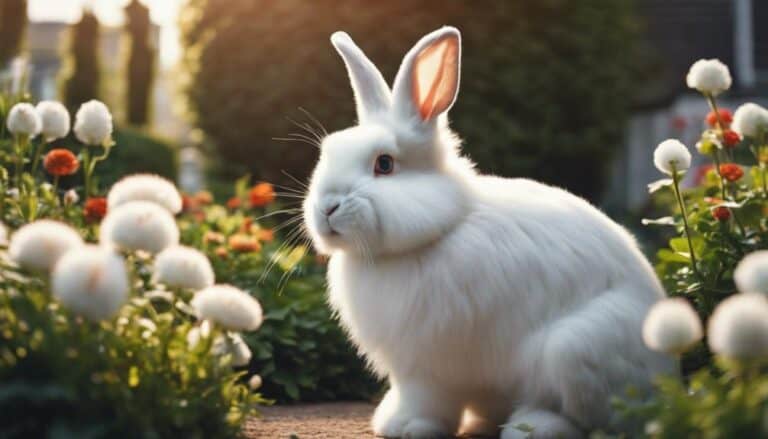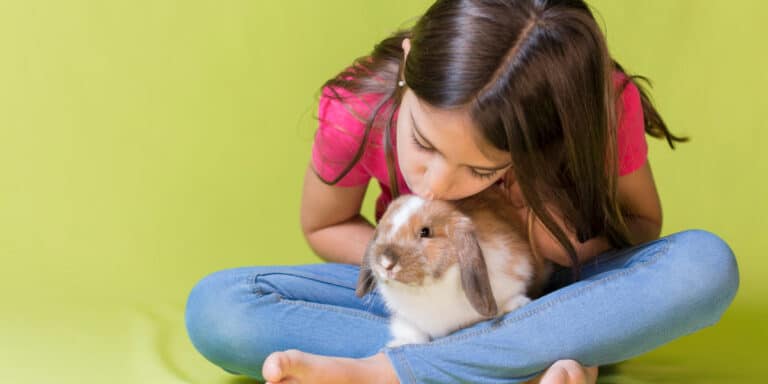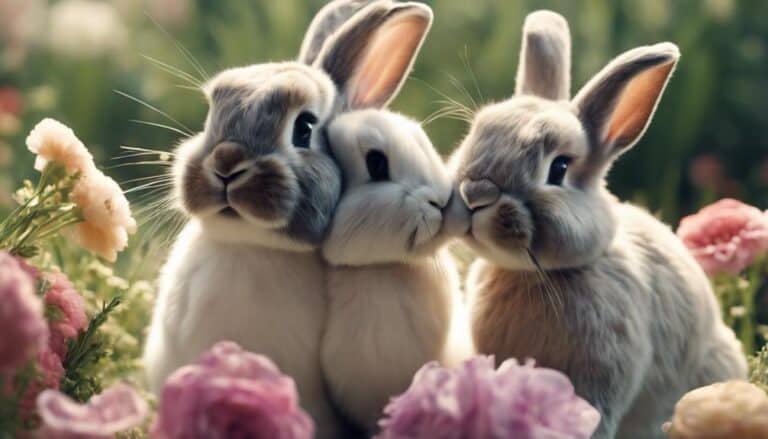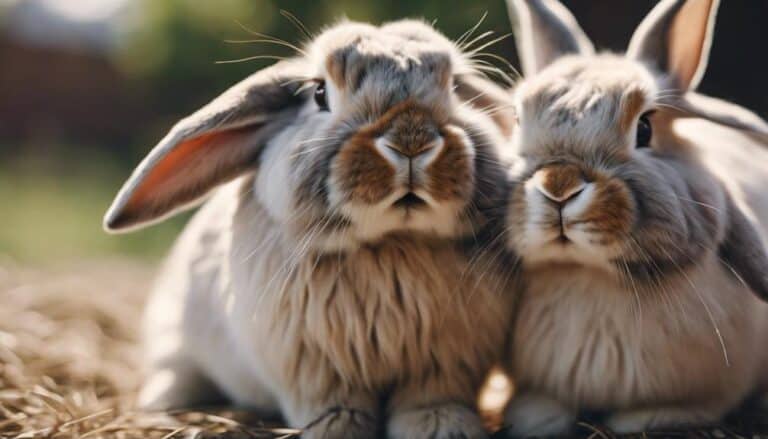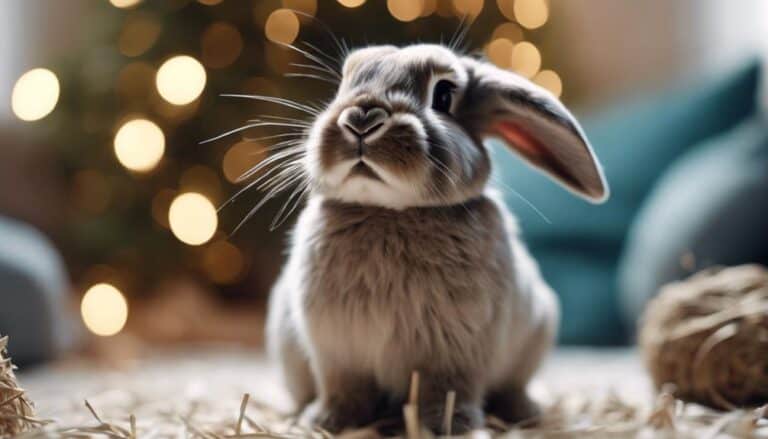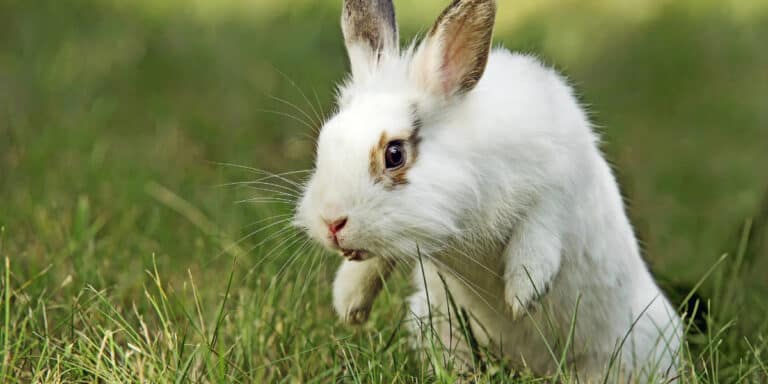You might think that bunnies are low-maintenance pets, but the truth is, their behavior is intricately linked to their environment.
Have you ever wondered how small changes in their surroundings could impact a bunny's demeanor and well-being? Understanding these subtle nuances can make a world of difference in ensuring your furry friend leads a contented and enriched life.
So, let's explore how the environment influences bunny behavior and discover practical tips to create a harmonious space that brings out the best in your beloved pet.
Contents
- 1 Key Takeaways
- 2 Bunny Habitat Requirements
- 3 Indoor Vs. Outdoor Living
- 4 Importance of Proper Bedding
- 5 Designing a Bunny Exercise Area
- 6 Ensuring Safety From Predators
- 7 Maintaining Optimal Ventilation and Temperature
- 8 Hygiene Practices for Happy Bunnies
- 9 Frequently Asked Questions
- 10 How Does the Environment Affect Bunny Group Dynamics and Hierarchy Establishment?
- 11 Conclusion
Key Takeaways
- Adequate space, ventilation, and secure hiding spots are crucial for promoting positive bunny behavior.
- Indoor and outdoor environments play vital roles in shaping a bunny's behavior and overall well-being.
- Proper bedding, including hay/straw, contributes to a comfortable and healthy environment, influencing bunny behavior.
- Enriching exercise areas with ample space, toys, and safe materials reduce stress and behavioral issues in bunnies.
Bunny Habitat Requirements
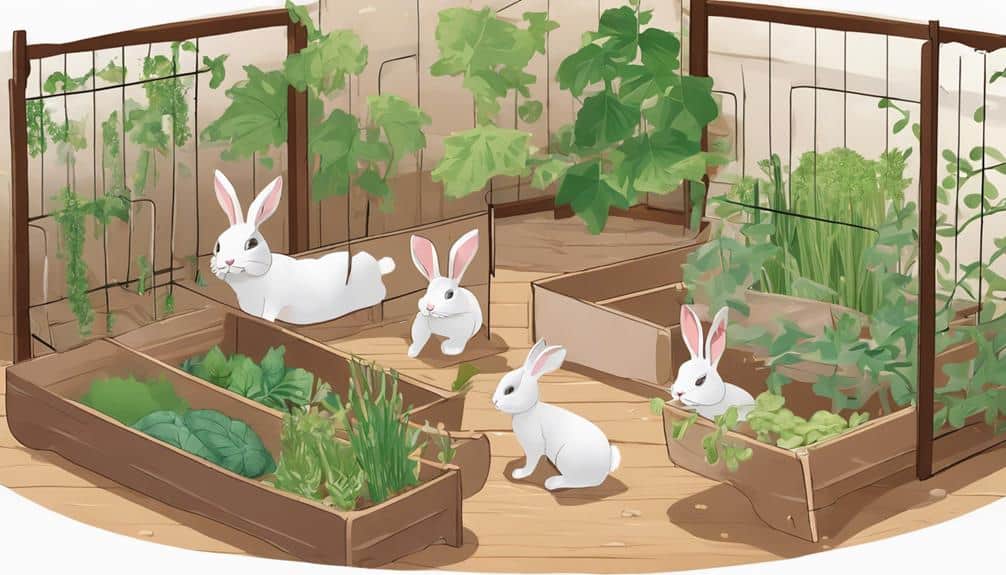
Ensuring rabbits have adequate space and ventilation in their housing is important for their overall well-being and health. When considering rabbit behavior and animal welfare, it becomes evident that providing an appropriate habitat is essential. Rabbits are naturally active and curious animals, requiring enough room to hop, play, and explore. Insufficient space can lead to stress and even health issues in these sensitive creatures. Proper ventilation is essential to prevent respiratory problems that can arise from poor air quality within their living environment.
Additionally, meeting the habitat requirements for rabbits includes offering secure hiding spots and safe resting areas. These elements contribute to the overall comfort and sense of security for the rabbits. By creating a habitat that mimics their natural environment, you're promoting behaviors that align with their instincts, ultimately enhancing their well-being.
Furthermore, maintaining a constant source of fresh water and using clean, dry bedding such as hay and straw are crucial aspects of ensuring a healthy and comfortable living space for rabbits. By prioritizing these factors, you're actively supporting the welfare of these delightful creatures.
Indoor Vs. Outdoor Living
When considering the living arrangements for rabbits, the choice between indoor and outdoor environments greatly impacts their behavior and overall well-being.
- Indoor living provides controlled environments, sheltering rabbits from harsh weather and potential predators, guaranteeing their safety and comfort.
- Outdoor living exposes rabbits to natural sunlight and fresh air, encouraging physical activity and mental stimulation, contributing to their overall health and happiness.
Indoor accommodations must be secure, cozy, and free of hazards such as electrical cords and toxic substances to promote a stress-free environment for rabbits.
Outdoor housing should include a secure exercise run attached to the living area, allowing rabbits to explore, play, and stretch their legs freely.
Both indoor and outdoor living spaces play pivotal roles in shaping a rabbit's behavior and well-being. It's essential to provide a suitable environment that meets their physical, mental, and emotional needs, whether indoors or outdoors, to guarantee a happy and healthy life for these beloved pets.
Importance of Proper Bedding
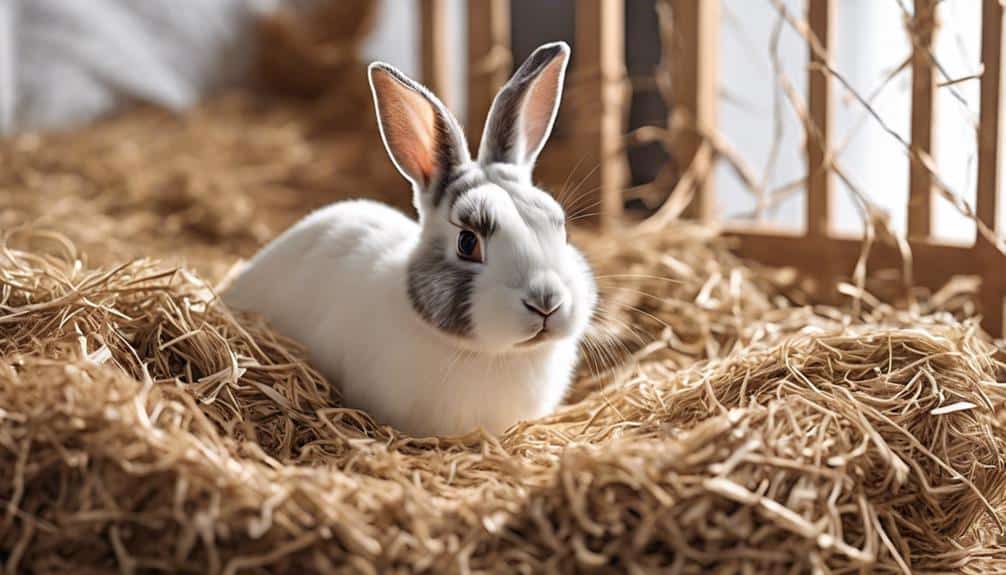
How important is proper bedding for maintaining the health and comfort of rabbits in their resting areas? Proper bedding plays a vital role in ensuring the well-being of your bunnies. When selecting bedding materials, opt for hay and straw as they provide insulation and comfort for your rabbits. These materials help create a suitable environment in their resting areas, promoting a cozy and secure space for them to relax. It's important to avoid using wood shavings as bedding since they can pose health risks to your furry friends.
Additionally, consider providing separate compartments for sleeping and eating/relaxing within their resting areas. This separation helps rabbits feel safe and secure, enhancing their overall comfort. Ensure that the resting areas are well-ventilated, dry, and free from draughts to maintain the best health for your rabbits. By paying attention to the bedding materials and the overall design of their resting spaces, you contribute to creating a happy and healthy environment for your beloved pets.
Designing a Bunny Exercise Area
When creating a bunny exercise area, you should focus on providing ample space for hopping and stretching. Incorporate various toys for promoting mental enrichment and ensure safety measures are in place.
By offering a spacious environment, engaging toys, and safe materials, you can encourage physical activity, mental stimulation, and overall well-being for your bunny.
Remember to take into account the layout, hiding spots, and toy rotation to create a dynamic and stimulating exercise area for your furry companion.
Space for Hopping
When creating a bunny exercise area, prioritize providing ample space for hopping and stretching comfortably, ensuring at least 12 square feet per rabbit. Including ramps, tunnels, and platforms can encourage natural behaviors and physical activity.
Rabbits require daily exercise to prevent obesity, maintain muscle tone, and promote overall well-being. Designing the exercise area with safe flooring materials like carpet, grass mats, or blankets is crucial to prevent slipping and injuries.
Regular access to a well-designed exercise area can reduce stress, boredom, and behavioral issues in pet rabbits, enhancing their overall quality of life. Remember, a spacious and stimulating exercise area is key to keeping your rabbits healthy and happy.
Toys for Enrichment
To guarantee a stimulating and engaging environment for your bunny's exercise area, incorporating a variety of toys is essential for promoting physical activity and mental stimulation. Rabbits thrive on environmental enrichment, and providing toys such as tunnels, balls, and puzzle feeders can keep them mentally sharp and prevent boredom.
Designing the bunny's play area with hiding spots, ramps, and tunnels encourages both physical activity and mental engagement, ensuring a well-rounded experience. Interactive toys, like treat-dispensing balls or problem-solving toys, can entertain your bunny while keeping them active and curious.
Remember to rotate toys regularly to maintain interest and prevent habituation. Including safe chewing toys made of natural materials will satisfy your bunny's natural urge to chew and help prevent dental issues.
Safety Measures Implemented
Incorporating safety measures when designing a bunny exercise area is paramount to guarantee the well-being and security of your furry companion. When creating a space for your pet rabbits, consider the following safety measures:
- Use non-toxic materials: Prevent harm from ingestion by ensuring all components are safe for your bunny.
- Avoid sharp edges and small parts: Minimize the risk of injuries by eliminating potential hazards in the exercise area.
- Incorporate tunnels, ramps, and platforms: Promote mental stimulation and physical activity to keep your pet healthy and engaged.
- Provide varied textures and hiding spots: Encourage natural behaviors and create a comfortable environment for your bunny.
Remember to regularly inspect and maintain the exercise area to address any safety concerns promptly.
Ensuring Safety From Predators
When safeguarding rabbits from predators, utilizing secure outdoor housing with predator-proof materials becomes important for their protection. Rabbits are vulnerable to various predators like foxes, raccoons, and birds of prey, making it vital to create a safe environment for them. Make sure that the outdoor enclosure is made of wire mesh or sturdy materials to prevent attacks on your rabbits. Additionally, providing a secure enclosure with a roof can protect them from aerial predators such as hawks and owls.
To enhance their safety further, offer your rabbits hiding spots within their living space. These hiding spots can help them feel secure and avoid potential threats from predators. Regularly inspect the outdoor environment for any signs of predator activity to maintain a safe space for your bunnies.
Maintaining Optimal Ventilation and Temperature
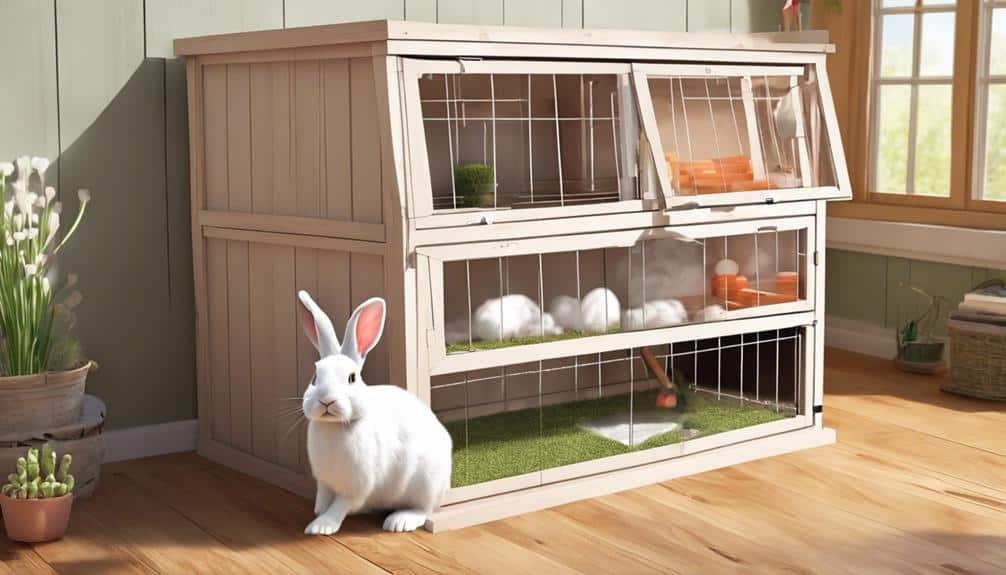
You observe the importance of proper ventilation for rabbits, noting their susceptibility to respiratory issues in inadequately ventilated areas.
Maintaining ideal ventilation not only regulates humidity levels but also helps prevent mold growth, creating a comfortable living space for your bunnies.
Ventilation Importance
Proper ventilation plays a critical role in safeguarding the respiratory health and overall well-being of rabbits. When contemplating the importance of ventilation in a rabbit's environment, it's vital to understand its impact on their health and behavior.
Here are some key points to take into account:
- Good ventilation helps regulate humidity levels and prevent mold growth in rabbit enclosures.
- Good air circulation guarantees the removal of ammonia and other harmful gases from the rabbit's living space.
- Maintaining suitable ventilation reduces the risk of heat stress during hot weather.
- Adequate ventilation contributes to a comfortable and healthy environment for rabbits to thrive in.
Temperature Regulation
Ventilation in a rabbit's environment not only impacts their respiratory health but also plays a significant role in regulating temperature to prevent heat stress. Essential ventilation is vital for temperature regulation, ensuring rabbits stay comfortable and healthy. Rabbits are sensitive to high temperatures, thriving best in ambient conditions between 60-70°F (15-21°C).
To help rabbits cope with heat, provide shade and cooling options like frozen water bottles. Conversely, in colder climates, insulated shelters and extra bedding aid in maintaining body heat and preventing hypothermia. Regularly monitoring indoor and outdoor temperatures is essential to safeguard your rabbits from extreme weather conditions.
Hygiene Practices for Happy Bunnies
Maintaining a clean environment for your bunny is essential for their health and happiness, with proper litter training and suitable materials playing key roles in promoting good hygiene practices. When considering hygiene practices for your rabbit, remember these important points:
- Consistent Litter Training: Rabbits are usually adept at using litter boxes, making it relatively easy to train them. Consistency is key to reinforcing this behavior.
- Safe Litter Materials: Opt for safe litter materials like paper pulp, aspen bark, or hay to guarantee a clean living space for your rabbit.
- Stress Management: Stressful events can disrupt litter box habits, emphasizing the need for a calm and peaceful environment for your bunny.
- Multiple Litter Boxes: Providing multiple litter boxes in a spacious area guarantees that your rabbit has easy access to clean elimination spots throughout their habitat.
Frequently Asked Questions
What Environmental Factors Affect Rabbits?
To help rabbits thrive, maintain proper temperature regulation by providing shelter options. Encourage diet diversity for health. Foster positive social interactions and offer safe spaces for predator avoidance. These factors greatly impact a rabbit's overall well-being.
What Can Influence Rabbits Behaviour?
Ever wondered what influences a rabbit's behavior? Social interactions, diet, human interaction, and stress levels all play a part. Engage with your bunny, provide a varied diet, and create a stress-free environment for a happy, well-adjusted pet.
What Is the Immediate Impact of Rabbits on the Environment?
Rabbits, with their grazing and burrowing, play an important role in maintaining ecological balance. They foster biodiversity conservation by dispersing seeds and creating habitats. Observing their impact on the environment reveals a delicate web of interconnected relationships.
How Are Rabbits Adapted to Their Environment?
In their environment, rabbits adapt by utilizing their keen senses of smell and sight, along with their swift running and jumping abilities, to evade predators. Their unique feces production also aids in nutrient absorption for survival.
How Does the Environment Affect Bunny Group Dynamics and Hierarchy Establishment?
The environment plays a vital role in shaping bunny group hierarchy dynamics. Factors such as space availability, food access, and predator threats can impact the social structure within a bunny group. The environment’s influence on resource distribution directly affects hierarchy establishment and maintenance among the bunnies.
Conclusion
As you observe your bunny in their well-designed habitat, you can see how the environment shapes their behavior. Like a sculptor molding clay, you have carefully crafted a space that promotes their well-being and happiness.
By providing the right shelter, bedding, and enrichment, you have created a canvas for your bunny to express themselves freely. Keep nurturing this environment, and watch as your bunny's personality shines brighter than ever before.

